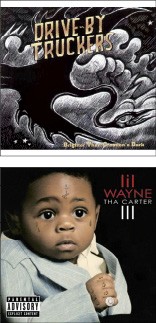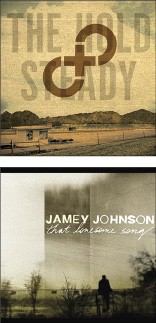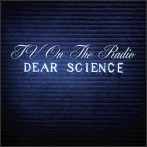With the digital revolution and breakdown of major labels leading to more recorded music, not less, the amount of new music released becomes more staggering each year. No one can keep up with it, but we were happy to try. Our critics report on their year of musical discovery:
Chris Herrington:
After extolling the virtues of Jay Reatard and Al Green in our local year-in-review piece a couple of weeks ago, I didn’t want to double-up here. For the record: Reatard would be number eight on the following list, while Green would be among the honorable mentions.
1. Hold On Now, Youngster … — Los Campesinos! (Arts & Crafts): As a sprawling, gender-balanced indie-rock ensemble whose music is not terribly guitar-driven, Wales outfit Los Campesinos! can’t help but resemble genre heavyweights Arcade Fire. But across a two-year body of work that includes two full-length albums and a gaggle of singles and EPs, these underdogs prove to be the smarter, funnier band. On Hold On Now, Youngster …, the first of their two 2008 albums, co-leaders Gareth and Aleksandra trade off verses like conjoined twins completing each other’s thoughts while their bandmates bop around behind them in a tumult of handclaps and vocal interjections, dancing to the breakbeats of broken hearts. This young band obsesses over their messy lives (favorite title: “My Year in Lists”) and is always ready with a sardonic rejoinder (“I cherish with fondness the day before I met you”). But they’re the kind of sarcastic, introspective wallflowers delighted to discover themselves having fun (“You! Me! Dancing!”). The music is springy, chaotic, breathless: It has to be to keep up with their overactive minds and racing hearts.
2. Brighter Than Creation’s Dark — The Drive-By Truckers (New West): Though Brighter Than Creation’s Dark peaks at the very beginning with the saddest, loveliest song Patterson Hood will ever write, it holds its shape for an epic 19 songs and 75 minutes. Hood takes the toll of the Iraq war from two vantage points, ruminates on road life, spits in the wind of recession, and tips his cap to printer-of-legends “the great John Ford.” Musical life-partner Mike Cooley spins one wonderful, low-rent character sketch after another, several of them probably autobiographical, led by a definitive metal-to-grunge saga he’s old enough to have lived and a shaggy confession that outs country storyteller Tom T. Hall as this great band’s biggest influence.
3. Tha Carter III — Lil Wayne (Cash Money/Universal/Motown): Lil Wayne is rap’s Al Green — an idiosyncratic vocal genius who combines cutesy with carnal while deploying a wide range of verbal registers and tics. This commercial tour de force is his best album because it’s the first time he’s reined in his logorrhea and put it at the service of so many conceptually focused songs. And while this 16-song, nearly 80-minute opus drags a little down the stretch — and would have been better as a tidy, 10-song banger climaxing with the Kanye West-produced “Let the Beat Build” — the reason it gets better over time is that Wayne’s dense, voracious, stream-of-consciousness rhymes constantly yield new surprises.
4. The Way I See It — Raphael Saadiq (Columbia): There are suddenly a surfeit of artists tapping into ’60s and ’70s soul sounds, but former Tony Toni Tone singer Raphael Saadiq has been working in the vein for 20 years now: He’s not a tribute artist; he’s a practitioner. And the nonstop groove, compositional detail, and sometimes surprising songwriting (“Keep Marchin'” the campaign theme Curtis Mayfield wasn’t around to write; “Sometimes” a family meditation of Smokey Robinson-level grace) on The Way I See It is the closest he — or anyone else — has been to the muse since his old band’s 1996 swan song, House of Music.
5. Made in Dakar — Orchestra Baobab (Nonesuch): The follow-up to this vintage Sengalese band’s unlikely 2002 comeback triumph Specialist in All Styles, Made in Dakar combines fresh versions of unknown-in-these-parts West African standards with new songs. As always, guitarist Barthélemy Attisso spins indelible melodies and launches entrancing grooves with his vibrant but deliberate style, while sax man Issa Cissoko offers droll, elegant counterpoint. The unavoidable comparison is the Cuban rehab project Buena Vista Social Club, but Orchestra Baobab is better — less folkie, more organic, not as molded by an outside producer. Made in Dakar is great groove music for body and soul.
6. Alphabutt — Kimya Dawson and Friends (K): Juno soundtrack star Kimya Dawson followed up her rather unlikely rise to fame with this silly, scatological concept album about kids and parents. With “friends” of all ages joining in to give the record a rambunctious, campfire spirit, Dawson lets songs about hungry tigers, splashing bears, and potty-training triumphs commingle with songs about pregnancy anxiety, schoolyard lessons on egalitarianism, and the ethics of food availability. This collection of deceptively simple acoustic ditties alternately for, to, and about Dawson’s own kid — and maybe yours too — is her most engaging album yet, though perhaps too sweet, too homely, and too messy for a lot of listeners.
7. Stay Positive — The Hold Steady (Vagrant): This fourth album from America’s most literate bar band opens with something of a master statement: “Constructive Summer,” which spins some Springsteenian imagery off a title almost surely inspired by Hüsker Dü’s “Celebrated Summer” before splitting the difference with a song-ending dedication to the Clash’s Joe Strummer. This fits an album where songwriter supreme Craig Finn literalizes more than ever his band’s mission to unite classic-rock grandeur with the regular-guy modesty and small-scale ethical sense of the hardcore and punk scenes that weaned him.
8. That Lonely Song — Jamey Johnson (Mercury Nashville): This been-to-hell-and-back-again Waylon Jennings fanatic covers his hero twice, references him once, and sings with the same garbled machismo. But Johnson’s damaged tales of hard living, divorce, and recovery are too detailed and lived-in to be merely outlaw cliché. And the best song here (well, aside from an opener that boasts the instant-classic lyric “That Southern Baptist parking lot is where I’d go to smoke my pot”) is a bit of modern Nashville songcraft that might be a Kodak commercial if it weren’t so tough and unsentimental.

9. Feed the Animals — Girl Talk (Illegal Art): By and large this masterful mash-up mix from Pittsburgh DJ Greg Gillis layers rap vocals over pop hits from the ’60s to the present. Though I do wish Gillis’ taste in hip-hop samples more often reached beyond the declamatory and pornographic, he mines his juxtapositions for plentiful comedy. And, musically, it never quits. The prurient party record of the year.
10: Vampire Weekend — Vampire Weekend (XL): From the write-what-you-know department: detailed, insightful, witty, and not at all uncritical evocations of collegiate lust over some the year’s most sprightly guitar pop. I suspect most criticisms of this pale, “privileged” band’s “appropriation” of Afropop forms (primarily a guitar sound, but with plenty of other rhythmic and vocal bits as well) come from people who don’t actually listen to much African music. Given that African guitar is one of mankind’s greatest achievements, this enthusiastic longtime Afropop dabbler only wishes more western guitar bands would follow suit.
Honorable Mentions: Conor Oberst — Conor Oberst (Merge); When Life Gives You Lemons, You Paint That Shit Gold — Atmosphere (Rhymesayers); Harps and Angels — Randy Newman (Nonesuch); Fearless — Taylor Swift (Big Machine); Primary Colours — Eddy Current Suppression Ring (Goner); Distortion — Magnetic Fields (Nonesuch); Alegranza — El Guincho (XL); Dear Science – TV on the Radio (Interscope); Oracular Spectacular — MGMT (Columbia); Rising Down — The Roots (Def Jam).
Top 10 Singles: “Paper Planes” — M.I.A. (XL); “Time to Pretend” — MGMT (Columbia); “Black President” — Nas (Def Jam); “More Like Her” — Miranda Lambert (Sony BMG/Nashville); “Gangsta Rap Made Me Do It” – Ice Cube (Lench Mob); “In Color” – Jamey Johnson (Mercury Nashville); “Lights Out” — Santogold (Downtown); “Takin’ Off This Pain” — Ashton Shepherd (Mercury Nashville); “Sequestered in Memphis” — The Hold Steady (Vagrant); “A Milli” — Lil Wayne (Cash Money/Universal/Motown).
Stephen Deusner:
1. Brighter Than Creation’s Dark — The Drive-By Truckers (New West); Stay Positive — The Hold Steady (Vagrant): Two of the most reliable rock bands further entrenched themselves in their respective regions, the Truckers telling more Southern stories with such natural verisimilitude that they have the force of literature and the Hold Steady hashing out dime-novel murder mysteries set in Midwestern college towns and set against mash notes to Iggy Pop and the Dillinger 4.
2. With Blasphemy So Heartfelt — Jessica Lea Mayfield (Polymer); Fearless — Taylor Swift (Big Machine): Mayfield worked with Black Keys’ Dan Auerbach to create a dark album about romantic resignation, while Swift worked with high-profile Nashville handlers to show that tween culture could transcend the Jonas Brothers. Laying it all out for the high school set, these two late-teen singer-songwriters reveled in youth while sounding older than their years.
3. Fleet Foxes — Fleet Foxes (Sub Pop); Awake My Soul: The Story of the Sacred Harp — Various Artists (Awake Productions): The joy of hearing many voices singing together: Their astonishing harmonies elevated Fleet Foxes’ debut above all the My Morning Jacket comparisons and dad-rock accusations, while the soundtrack to Matt Hinton’s shape-note-singing doc made rock stars of small-town congregations.

4. That Lonesome Song — Jamey Johnson (Mercury Nashville); 808s & Heartbreak — Kanye West (Roc-a-Fella): Break-ups fueled these two artists’ similarly themed albums. West’s anger at his cold-hearted ex is offset by his constant self-mutilation via Autotune, while Johnson simply directs his ache inward to create a doom-laden country album that’s as self-assured as it is self-loathing.
5. Hercules & Love Affair — Hercules & Love Affair (Mute); Dear Science — TV on the Radio(Interscope): Two different visions of dance music, one looking backward and the other forward: Herc’s disco portrayal of the dancefloor as perpetual gay safehaven gives the modern beats a mirrorball heart, while TV on the Radio’s examination of race and sexuality lends their rock-oriented rhythms a distinguishing braininess.
Honorable Mentions: Robyn— Robyn (Cherrytree/Interscope); Dig Lazarus Dig!! — Nick Cave & the Bad Seeds (Mute); Carried to Dust — Calexico (Touch & Go); Jeanius — Jean Grae (Blacksmith); Asking for Flowers — Kathleen Edwards (Rounder).
Andrew Earles:
1. Dear Science — TV on the Radio (4AD/Interscope); Smile — Boris (Southern Lord): Every time I see Dear Science topping someone’s year-end list, I’m elated that something this inventive has reached mainstream popularity. But I also wonder if we’ve simply become too lazy to embrace genuinely bold music. Smile adds the important elements of “challenge” and “risk.” It is not safe music, like Dear Science, but it is beautiful music if given the proper chance. Dear Science‘s feat is that it masterfully cherry-picks influences and styles that only deeply imbedded music nerds know about then repackages all of it into music that won’t alarm anyone’s parents. It’s the Wilco/Radiohead trick to an extreme. Part of the reason the Velvet Underground, Black Sabbath, Black Flag, and Sonic Youth were so important is that, in their respective days, anyone over the age of 45 would recoil from and denounce the music. Smile feels like one of those historical checkpoints.
2. Third — Portishead (Mercury/Island): Third is not a comeback because Portishead never made music this arresting; never even came close. This is the stark, moving music that Stereolab would be making today if they hadn’t spread themselves so thin with 400 albums in 15 years.
3. The Ace of Hearts Reissues — Mission of Burma (Matador): To date myself, Rhodes College’s WLYX collapsed into obscurity not long after introducing me to bands like Hüsker Dü and Mission of Burma, and I’ll never forget the pathetic Saturday night alone at home when my lost 15-year-old ears were filled with “Revolver,” a song that has since become the “Mustang Sally” of post-punk. The past 20 years of indie rock, emo, post-hardcore, etc., would be a completely different animal without this band.
4. Meanderthal — Torche (Hydra Head): Aside from a three-month blackout in Cabo, I never thought I’d have anything in common with Sammy Hagar fans, but Meanderthal actually makes me drive recklessly. It’s more a lack of careful attention than exceeding the posted speed limit or rutting people’s yards in a rock-and-roll frenzy, as this is an album that demands full attention while rewarding listeners with what is more or less a simple formula: heavy rock-influenced hardcore and metal driven by golden pop hooks.
5. Nouns — No Age (Sub Pop): No Age’s Nouns is like a Time-Life Music infomercial of forgotten bizarro-pop brilliance from 10 to 15 years ago (Thinking Fellers, Sebadoh, Swirlies, some Guided By Voices). Unlike other bands who turn calculatedly “crappy” production values into an important, deliberate sonic element, No Age writes killer songs.
Honorable Mentions: Pyramids — Pyramids (Hydra Head); Alight of Night — Crystal Stilts (Slumberland); Saint Dymphna — Gang Gang Dance (Social Registry); The Chemistry of Common Life — Fucked Up (Matador).
